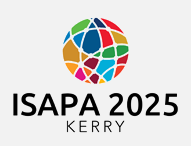Start Date
17-6-2025 9:00 AM
End Date
17-6-2025 10:30 AM
Abstract
Introduction: Children with CHARGE syndrome (CS) develop fundamental motor skills more slowly than peers without disabilities (Perreault et al., 2021). Structural constraints are a primary factor, but parental influence also plays an important role. Research suggests a positive relationship between parents' perceptions of their child’s motor competence, the frequency of practicing motor skills with their child, and their child’s actual motor competence (Haibach-Beach et al., 2021). However, a study on a home-based motor skill intervention found that parents were less likely to teach motor skills they felt less confident in, emphasizing the need to understand parents' confidence in teaching motor skills to their child (Lieberman et al., 2021). This study explored how parents of children with CS perceive their motor skill teaching competence (PTC) to children with and without CS, and how this relates to their perceptions of their child’s motor competence (PMC). Method: Thirty-six parents of children with CS completed a questionnaire that assessed their PTC and PMC of their child for 13 fundamental motor skills. Results: Results showed that parent’s PTC for children without CS was significantly higher for all motor skills compared to their PTC for children with CS. PTC for children with CS was positively related to PMC for the slide (r=.520, p=.003) and one-arm strike (r=.529, p=.003) while PTC for children without CS had a positive relationship with PMC for the run (r=.381, p=.038). Conclusion: Overall, parents feel less confident teaching motor skills to children with CS than children without CS. Providing parents with resources to improve their teaching confidence may help to enhance motor development for their child with CS.
References
Haibach-Beach, P., Perreault, M., Lieberman, L., & Stribing, A. (2021). Associations between parent perspectives and motor competence in children with CHARGE syndrome. Journal of Motor Learning and Development. https://doi.org/10.1123/jmld.2020-0057
Lieberman, L., Haibach-Beach, P., Perreault, M., Bebrisa-Fedotova, L., & Brian, A. (2021). Feasibility of a home motor skill intervention for children with CHARGE syndrome. Research, Advocacy, and Practice for Complex and Chronic Conditions, 40(1), 4-23. https://doi.org/10.14434/rapcc.v40i1.31710
Perreault, M., Haibach-Beach, P., Lieberman, L., & Foster, E. (2021). Motor competence in children with CHARGE syndrome. Research and Practice for Persons with Severe Disabilities, 46(2), 67-76. https://doi.org/10.1177/1540796921998011
Recommended Citation
Perreault, Melanie; Beach, Pamela; and Lieberman, Lauren, "Parental Perceptions of Teaching Competence of Children with and without CHARGE Syndrome" (2025). International Symposium of Adapted Physical Activity and International Symposium on Physical Activity and Visual Impairment and Deafblindness. 15.
https://sword.mtu.ie/isapa/2025/day2/15
Parental Perceptions of Teaching Competence of Children with and without CHARGE Syndrome
Introduction: Children with CHARGE syndrome (CS) develop fundamental motor skills more slowly than peers without disabilities (Perreault et al., 2021). Structural constraints are a primary factor, but parental influence also plays an important role. Research suggests a positive relationship between parents' perceptions of their child’s motor competence, the frequency of practicing motor skills with their child, and their child’s actual motor competence (Haibach-Beach et al., 2021). However, a study on a home-based motor skill intervention found that parents were less likely to teach motor skills they felt less confident in, emphasizing the need to understand parents' confidence in teaching motor skills to their child (Lieberman et al., 2021). This study explored how parents of children with CS perceive their motor skill teaching competence (PTC) to children with and without CS, and how this relates to their perceptions of their child’s motor competence (PMC). Method: Thirty-six parents of children with CS completed a questionnaire that assessed their PTC and PMC of their child for 13 fundamental motor skills. Results: Results showed that parent’s PTC for children without CS was significantly higher for all motor skills compared to their PTC for children with CS. PTC for children with CS was positively related to PMC for the slide (r=.520, p=.003) and one-arm strike (r=.529, p=.003) while PTC for children without CS had a positive relationship with PMC for the run (r=.381, p=.038). Conclusion: Overall, parents feel less confident teaching motor skills to children with CS than children without CS. Providing parents with resources to improve their teaching confidence may help to enhance motor development for their child with CS.
References
Haibach-Beach, P., Perreault, M., Lieberman, L., & Stribing, A. (2021). Associations between parent perspectives and motor competence in children with CHARGE syndrome. Journal of Motor Learning and Development. https://doi.org/10.1123/jmld.2020-0057
Lieberman, L., Haibach-Beach, P., Perreault, M., Bebrisa-Fedotova, L., & Brian, A. (2021). Feasibility of a home motor skill intervention for children with CHARGE syndrome. Research, Advocacy, and Practice for Complex and Chronic Conditions, 40(1), 4-23. https://doi.org/10.14434/rapcc.v40i1.31710
Perreault, M., Haibach-Beach, P., Lieberman, L., & Foster, E. (2021). Motor competence in children with CHARGE syndrome. Research and Practice for Persons with Severe Disabilities, 46(2), 67-76. https://doi.org/10.1177/1540796921998011

